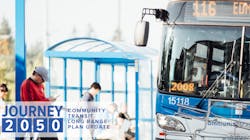Community Transit opens public feedback period on Journey 2050
Community Transit is looking for public feedback from Snohomish County residents on Journey 2050, the agency’s draft long-range plan. The plan reflects community priorities, as well as changes in regional transportation options and outlines a service vision in response to major growth expected in the county. The final plan will guide Community Transit’s investments in services and infrastructure for decades, setting the course for how people will use transit in their daily lives, whether it’s to travel to appointments, work, school, shopping, airport trips or events throughout the region.
Journey 2050 builds on the agency’s vision for expanding transit service and incorporates several fundamental changes:
- Service growth ─ Significantly increase service to meet the needs of the county, particularly in regional growth centers with high concentrations of people and jobs. Types of services include Swift bus rapid transit (BRT); regular bus service with improved frequency and connections and innovative services such as the Zip Alderwood Shuttle.
- Regional transit expansion ─ Continue to optimize the transit system in Snohomish County in alignment with regional transit expansion, including connecting to light rail and regional BRT.
- Emerging mobility options ─ Develop new and innovative service types such as Zip to improve mobility options for the community. This may include on-demand or flexible route services and existing services such as Dallas Area Rapid Transit paratransit and Vanpool.
- Zero-emissions fleet ─ Set a goal of transitioning to a zero-emissions fleet by 2044 in order to reduce the impact on the environment. Transforming the fleet from diesel-powered to zero-emissions buses is the largest single investment Community Transit has planned to date.
The Community Transit Board of Directors will consider the draft plan at the Dec. 7 board meeting. Members of the public can comment on the plan in a variety of ways, including by survey, webinar, public hearing, phone, email and social media, through Nov. 2. The plan can be found at Community Transit’s website.
